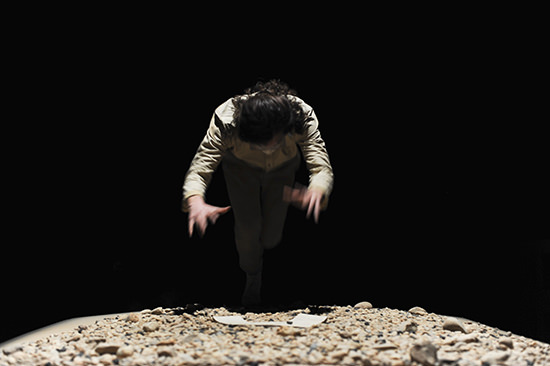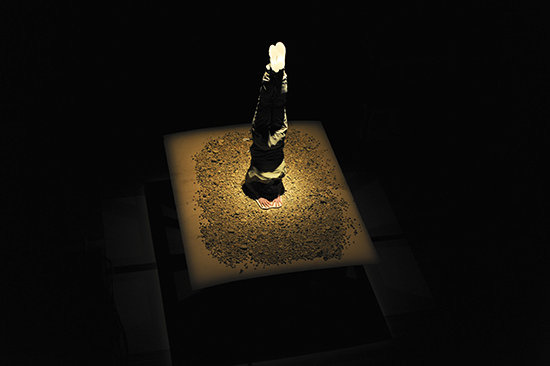The aesthetics of kinetic impact
Nikki Heywood: Tim Darbyshire, Stampede the Stampede

Tim Darbyshire, Stampede the Stampede
When choreographer Tim Darbyshire chooses to work with fundamental principles such as turbulence, duration and rupture in performance he does so by surrendering agency to the movement of machines and situates himself among the elemental rawness of rock and dust. He invites invisible forces of vibration and gravity to act upon his body over just enough time for the viewer to become a participant in his dystopic ordeal. The aural and spatial constructions provided by his sound and design team offer a seamless collaboration, creating an environment of powerful affect.
Darbyshire appears in dim light, hunched and slow moving, turning atop a tall wooden tower. A kind of Everyman in crumpled nondescript pale shirt and trousers, he circles, ponderous as a beast in a lair. The soundscape begins as a hum and transmutes into electronic scratching on a digital blackboard.
He sways on his haunches to a growing, insistent beat and with each repetition his body rises and falls until compelled by tempo it explodes upwards, long hair and arms swinging. There is an inevitability about this evolution of impact as mechanical rhythms command an inner spring of muscular impulse, fast twitching, switching, turning. Head and torso gain and lose momentum, human spheres in a fleshy Newton’s Cradle. He’s raising dust, dividing and subdividing the beat, then slowing down, minimising movement to stillness.
From this caesura point of pause, the man standing high and bare, we hear a sudden snap—sense the rupture in our own guts—as with a breathtaking gallows drop he falls feet first through the platform roof, from top to bottom of the tower.
Embodying the momentum of energy available within a closed system, Darbyshire appears subject to the laws of entropy, moving under pressure from order to disorder. This theme is amplified in Stampede the Stampede, beginning as an assault on the performer’s senses from the outside by sound or mechanical device, creating an eruption from within his body, firing movement that gathers almost to excess and then dissipates in his exhaustion or collapse.
Now at ground level in the tower, lit from the inside, Darbyshire is captive in a transparent Tardis-like box bombarded by a storm of language. A harsh machinic voice multiplies itself: “ag-it-a-tion, rev-el-a-tion, fab-ric-a-tion, alt-er-a-tion, stim-ul-a-tion, prob-ab-il-it-y, an-xi-et-y.” Pummelled by this long list of nouns, he dons a dust mask, earplugs and goggles to block his senses and prepare for the next intense episode.
Another portal ruptures as Darbyshire bursts through a low trapdoor, work lights snap to brightness and the scratchy drone returns. Moving slowly along a predetermined track as though on a conveyor belt, face covered, he gathers weight as his pace quickens to a trot and he makes a quick jump onto a low, gravel-strewn platform.

Tim Darbyshire, Stampede the Stampede
On this central bed of rocks Darbyshire prepares himself before inverting to hold a long headstand. The whole structure begins to vibrate and he becomes a human jackhammer, head drilling down, going nowhere, long shoelaces dangling. He sustains his position as long as possible then drops and readjusts, returning to the headstand. He does this again and again and as the earth beneath him shakes, rocks gravitate slowly to the edge, fall and bounce with speed and dust swirls around the vertical figure, like a doomed man in a post-mining purgatory.
As he endures the deep onslaught of bass-toned vibrations, absorbed through the top of his head and his hands, there is time for us to wonder. Imagining the shock to his muscles and organs, mesmerised amid our own personal, mythic associations triggered by the sparse composition of elements, we witness a body both subject to and complicit in forces outside of itself in this choreography of kinetic impact. Darbyshire doesn’t hide the preparation required to repeatedly return to the strenuous operation. Rocks give themselves up to gravity, he gives himself up to the unending quake. He must stay till all the rocks are gone, the surface stripped.
We witness the gradual erosion. We witness his responses and endurance. His bones must be rattled, jaw and skull jarred. Dominated by unseen remote force, he holds out until the excavation is complete and eventually slumps, then crawls, demonic, moved like the rocks towards the edge. He drops to the floor and comes to standing. How can his mobile molecules be still? Divesting mask, goggles, earplugs, his next slow transit leads to the third platform.
He climbs aboard, hoists into harness, hangs limp at first as though dead. As this new ground revolves beneath him, he lifts to stand supported, then flips upside down in the sling. A suspended falling, fallen angel turning on a sixpence, turning on only a fingertip’s contact with the turntable for a moment. Eventually he floats, he flies, blown by the wind of fans below. He opens and closes as though over a burning pit in Dante’s Inferno, and then I see a disfigured painterly Baconesque body reduced to spinning, spinning, spinning, eternally in dust and finally liberated in darkness.
While Tim Darbyshire enjoys the notion of a stampede’s “absurd irrationality”—where a surge of herd movement begins with “no clear direction or purpose”—he and his collaborators have assuredly created a world with a strange yet captivating inner logic. They have led me on a quixotic tour, swinging between detachment and visceral empathy. Spun, shaken, dropped, lifted, slightly brutalised, I come to land, immensely impressed.
–
Stampede the Stampede, choreographer, performer, voice Tim Darbyshire, sound design Madeleine Flynn & Tim Humphrey, set & lighting design Jennifer Hector & Bosco Shaw, Producer Alison Halit; Campbelltown Arts Centre, Sydney, 19-20 Aug
RealTime issue #134 Aug-Sept 2016






